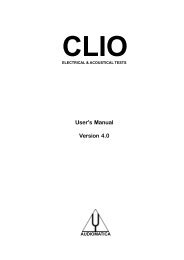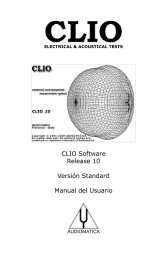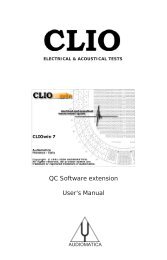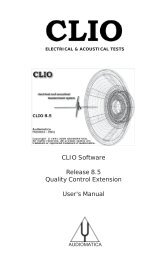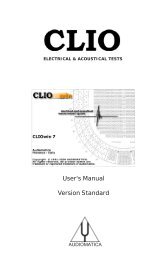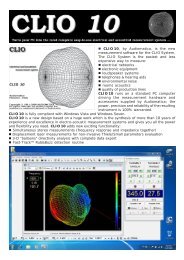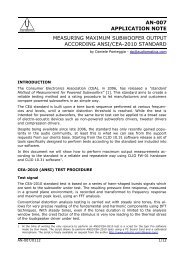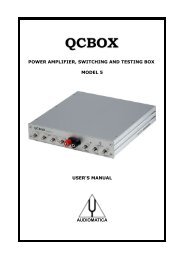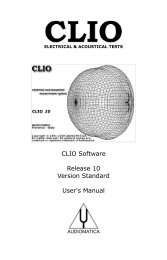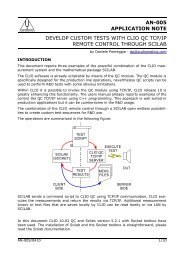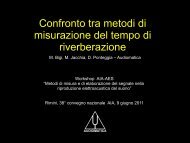CLIOwin 6.5 PCI User's Manual - Audiomatica Srl
CLIOwin 6.5 PCI User's Manual - Audiomatica Srl
CLIOwin 6.5 PCI User's Manual - Audiomatica Srl
Create successful ePaper yourself
Turn your PDF publications into a flip-book with our unique Google optimized e-Paper software.
10.4.4 PHASE & GROUP DELAY<br />
We used the term "Frequency Response" to refer to graphics the kind of Fig.10.5 and<br />
Fig.10.8. Frequency is in the x-axis in both figures. The units that respond to frequency,<br />
y-axis, are Volt and Ohm, respectively. Both of them are complex quantities (have real<br />
and imaginary part) and their magnitude is shown. Doing this we obtained a very<br />
useful piece of information but we lost the original data (infinite numbers of different<br />
real and imaginary part can lead to the same magnitude). How this information loss will<br />
affect your life depends on what you are going to do with these graphs, or, better, which<br />
was the original question you were trying to answer. Referring to Fig.10.5. A reasonable<br />
question could have been: how much does "A" filter attenuate signal at 100Hz in respect<br />
to 1kHz? You go trough the graph with the marker and answer 19.3dB. If you have the<br />
IEC 651 norm you can go to the "A" filter specs and you will find this attenuation should<br />
be 19.1dB +- 0.5dB for type 0 devices. End of your job. Lets now pose another question<br />
referring to Fig.10.8: how much a 10kHz tone would be attenuated if we wire a 10 ohm<br />
resistor in series with that woofer? We are simply not able to give the correct answer.<br />
We need another piece of information, which is PHASE. Fig.10.19 is the same measure<br />
of Fig.10.8 with phase curve overlaid. To obtain it we just stored the magnitude curve<br />
and clicked on the phase button.<br />
150.0<br />
CLIO<br />
180.0<br />
Ohm<br />
Deg<br />
120.0 108.0<br />
90.0 36.0<br />
60.0 -36.0<br />
30.0 -108.0<br />
0.0 -180.0<br />
20 Hz<br />
100 1k 10k 20k<br />
Figure 10.19<br />
To acoustic devices the same principles applies. Fig.10.20 shows the magnitude<br />
response of woofer and tweeter in a box without cross-over network.<br />
110.0<br />
CLIO<br />
180.0<br />
1.00<br />
V<br />
CLIO<br />
dBSPL<br />
Deg<br />
0.80<br />
100.0 108.0<br />
0.60<br />
0.40<br />
90.0 36.0<br />
0.20<br />
0.00<br />
80.0 -36.0<br />
-0.20<br />
-0.40<br />
70.0 -108.0 -0.60<br />
-0.80<br />
60.0 -180.0 -1.00<br />
0.00 20 Hz<br />
100 1k 10k 20k<br />
1.6 3.2 4.8 6.4 8.0 9.6 11 13 14 16<br />
ms<br />
Figure 10.20 and 10.21<br />
The two measurements were taken from the same microphone position. Should we ask<br />
ourselves which is the summed output we could not answer from the magnitude data<br />
alone. Unfortunately acoustic phase is not so easy to handle as electric phase. We are<br />
going to base our example on the tweeter, whose impulse response and window settings<br />
are in Fig.10.21. Procedure for woofer would be exactly the same.<br />
96 Chapter 10 - MLS



